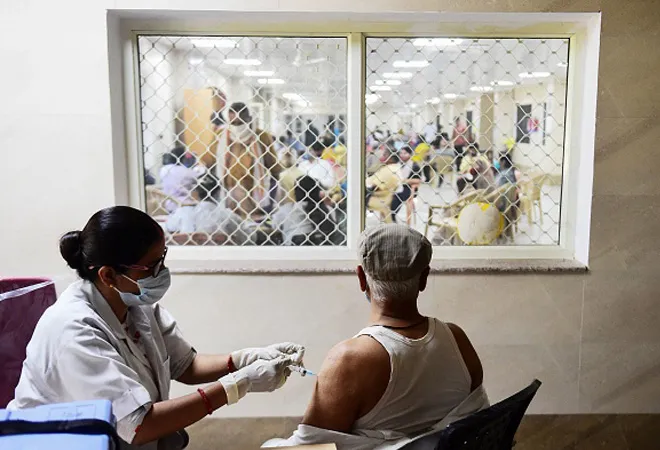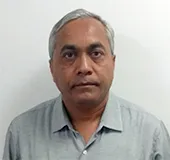
This article is part of the series The COVID-19 Vaccine Challenge: Contextual and Country Analysis.
The uniqueness of vaccination places it as a global public good, by virtue of it driving positive externalities, enabling human beings to prevent infections and death. Expectedly, nation-states have been engaging in intense nationalism, creating deep-rooted divisions and exacerbating inequity in the access to treatment and prevention against COVID-19. Microbial living organisms do not distinguish between nations, sectors (public vs private), and place of residence (rural vs urban). The outcome from vaccination is inherently and uniquely poised to permeate the boundaries of countries, sectors and residence. Emerging evidence shows that both global as well as national responses have been, at best, sub-optimal. Notwithstanding the achievements made so far, the task before the India is enormous, multiple, and complex. We outline the challenges and potential pathways to achieving universal vaccination. The difficulties and solutions that underlie the current vaccination effort are present across the value-chain and require urgent attention. We outline the following key dimensions for potential solutions: Financing, pricing, production, procurement, supply chains, and delivery channels.
The difficulties and solutions that underlie the current vaccination effort are present across the value-chain and require urgent attention.
Financing Vaccination
Given its public health characteristics involving positive externalities, the Universal Immunisation Programme (UIP) and its earlier avatars have been traditionally funded by the central government. Similarly, the Union had allocated funds to COVID-19 vaccines since January 2021 by spending about INR 360 crores on vaccines for healthcare workers and frontline workers in the country. Prioritising further, it had identified the 45+ age group for coverage and then the 18+ age group with an outlay of INR 35,000 crores during 2021–22. This was expected to relieve state governments from spending on procuring vaccines and enable them to focus on strengthening supply chains and the delivery of vaccines at frontline facilities. Realising the importance of vaccinating the entire adult population of about 914 million, a one-time allocation to COVID-19 vaccines is laudable. However, since vaccination for the 2-18 years’ age group is imminent and inevitable, and it involves 448 million children and adolescents, an additional outlay of funds would be required to inoculate the children during 2021–22. Presently, the Government of India has been procuring at INR 150 per dose for Covishield and Covaxin during March to July 2021; a rough estimate of the cost to inoculate the population works out to INR 30,109 crores including children (2-18 years) and adults (>19 years), assuming 75 percent uptake will be by the government. Whereas, if cost per dose is expected to increase to INR 215 and Rs. 225 per dose for Covishield and Covaxin respectively, the final outlay will be INR 44,160 crores for covering both the child and adult population.<1>
Since vaccination for the 2-18 years’ age group is imminent and inevitable, and it involves 448 million children and adolescents, an additional outlay of funds would be required to inoculate the children during 2021–22.
Pricing vaccines
In a resource-poor setting, public procurement of vaccines and drugs in the past has often been made employing procedures that are accountable and transparent. This involved open tender purchase offering supply sourced from L1 producers. However, since the capacity to produce COVID-19 vaccines were limited by a few manufacturers, a negotiated price is still a sub-optimal solution. A negotiated price should have been preceded by an open tendering process that would have ideally led to a true price discovery. Paying for a vaccine whose cost of production is unknown but expected to be a fraction of the total cost had led to four different prices being negotiated. A differential price stemming from negotiated price points reveal a procedure that failed to utilise economies of scale and the associated monopsony power. This is likely to make a dent on the exchequer in specific and at a broader level is expected to negatively impinge on societal cost to citizens.
Vaccine production
India is a global pharmacy, producing and exporting drugs and vaccines to most nations globally. Before the pandemic, Indian vaccine manufacturers cumulatively had an installed capacity to produce 8.2 billion doses of various vaccines per annum. However, only the Serum Institute of India producing Covishield and is the largest vaccine producer, along with Bharat Biotech manufacturing Covaxin were initially mandated to produce COVID-19 vaccines. Taking into account the need to produce 1.83 billion doses for domestic consumption to be administered amongst the adult population and, perhaps, an even far greater need to supply to developing countries, all other producers—Panacea Biotec, Sanofi Shantha Biotechnics, Biological E, Hester Biosciences and Zydus Cadila—should be brought in now to respond to supply bottlenecks. Besides, the public sector players—Central Research Institute, BCG Vaccine Laboratory, Pasteur Institute of India, Haffkine Biopharmaceutical Corporation, Indian Immunologicals, Bharat Immunologicals and Biologicals (BIBCOL)—must also be engaged proactively to produce and deliver vaccines, although some of them are unlikely to start production in the near future. The BIBCOL, for instance, is set to begin production only in February 2022, with a capacity of 10 million doses per month. Thus, the only way to avert the current vaccine shortage is to augment production capacity by involving as many quality producers as possible who are already an established players in vaccine production. This is imperative given another 846 million doses would be required to be manufactured for the 2-18 age group, once regulatory approval for inoculation of children and adolescents is obtained.
The only way to avert the current vaccine shortage is to augment production capacity by involving as many quality producers as possible who are already an established players in vaccine production.
With Sputnik, Pfizer, and other vaccines set to enter the market and their production beginning soon, some of the shortages may be halted and supplies are likely to be augmented further. Moreover, relying on two vaccines alone has already stifled the current capacity, hence, efforts should be made to invoke compulsory licensing procedures, a legitimate policy instrument allowed in a health emergency under the TRIPS agreement, rather than waiting for the outcome from the TRIPS waiver debate at the World Trade Organisation. In the face of opposition from a few countries, this route is either closed or will require a long wait. As a sovereign nation and an embattled country amidst a pandemic, India must invoke compulsory licensing provisions to ensure that more producers are made to manufacture and augment existing capacity. Moreover, Covaxin, which is a domestic innovation financed partially by tax payers’ funds, must be allowed to be produced by other Indian public and private vaccine manufacturers, in which case, the need for invoking compulsory licensing will be eliminated.
Vaccine consumption
As of August 19, India has already achieved administering over 570 million vaccine doses, including two doses of over 127 million—a feat of rapid and significant coverage globally.
One source of significant shortfall in vaccination could be due to the 25 percent quota of vaccines reserved for the private sector, with the current rate of vaccination in private facilities being as low as 7 percent since the start of the vaccination drive.
However, the inequity in administering vaccines remains stark across states, with the national shortfall in vaccines being over 50 percent. While shortfalls in Kerala (22 percent), Delhi (22 percent), Punjab (26 percent), Karnataka (30 percent), Gujarat (37 percent), remains much below the national shortfall, other major states in the north appear to be falling way behind the national average, particularly Bihar (71 percent), Rajasthan (66 percent), West Bengal (66 percent), Uttar Pradesh (64 percent), and Jharkhand (62 percent). As more vaccines are introduced after regulatory approvals—Sputnik and Novavax, and with few more producers—Dr. Reddy’s Lab., Biological E, and imports—Cipla to import Moderna vaccine, coming into play, production is expected to significantly expand capacity, halting shortages and augmenting uptake from 4 million doses per day currently to double or triple of this number. One source of significant shortfall in vaccination could be due to the 25 percent quota of vaccines reserved for the private sector, with the current rate of vaccination in private facilities being as low as 7 percent since the start of the vaccination drive. A high vaccine price—INR 1,410 per dose for Covaxin in private institutions as against INR 250 per dose procured by the Government of India; and INR 780 per dose for Covishield in private institutions as against INR 150-250 per dose procured by the government—led to a relatively lower level of service charge (capped at INR 150) being imposed upon private players, which is believed to be a disincentive for private centres to enhance the vaccination drive.
Summing up
The road to universal vaccination against COVID-19 is littered with potential challenges. A nationally fully-funded inoculation programme produced by multiple manufacturers complemented by a price competitive regime is the need of the hour. The societal benefit of government-funded vaccination significantly outweighs market-oriented vaccination of even rich households. By avoiding a fragmented procurement and supply chain, a national pooled procurement mechanism has the advantage of reaping economies of scale and monopsony purchasing power. Such a mechanism is not only cost-effective for the government, but the society will benefit at the broader level. Even if the private sector were to provide vaccines that are affordable to the wealthy, vaccination as a public good should be guided on the principle of preventing infection rather than an ill-informed narrative around affordability.
<1> Authors’ estimate based on average price per dose and age group distribution of population by children and adults, utilising population projections for 2011-2035, Ministry of Home, Government of India
The views expressed above belong to the author(s). ORF research and analyses now available on Telegram! Click here to access our curated content — blogs, longforms and interviews.




 PREV
PREV


